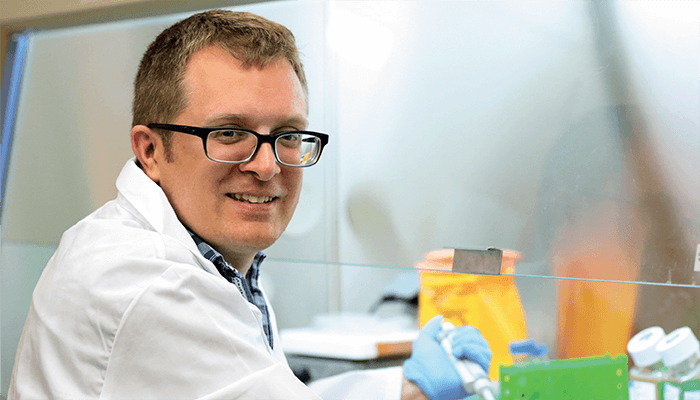Tell us about the past four years…
Two very memorable milestones come to mind. The first was receiving tenure and the second involved being no longer eligible for the Top 40 Under 40 list! Hitting 40 years old is now very much in the rear-view mirror. But I have also discovered the best medicine for aging: my students’ passion to learn and excitement to discover. The continued success of the lab and my receiving tenure is a testament to the dedicated and creative students and postdocs that make our science possible. And I am forever grateful to each of them.
What are you working on at the moment?
I am currently an associate professor in the Department of Chemistry at the University of North Carolina at Chapel Hill, US. The lab continues to develop micro- and meso-fabricated devices to generate 3D tissue-like environments to study intercellular signaling and develop disease progression models. A major effort over the last few years – and one that is starting to bear fruit – is the incorporation of targeted metabolomics to quantify drug metabolism in 3D colorectal tumor model and in a 3D liver model. A common theme for many of the bioanalysis-related projects in my lab is making tools and model systems to characterize the role oxygen plays in regulating cellular responses to drugs. With our 3D tumor model, we are exploring how a lack of oxygen promotes drug resistance. In the 3D liver model, we are evaluating how incorporating physiologically relevant tissue environments maintains hepatocyte function and regulates drug metabolism.
We also recently became part of a multi-institution DOE Energy Innovation Hub, CHASE (Center for Hybrid Approaches in Solar Energy to Liquid Fuels). This multidisciplinary research environment allows me to focus on my other research passion: developing models to better understand the role of disorder, the heterogeneity that arises from chemically modified surfaces and electrodes that cannot self-assemble. In this area of the lab, I am learning all sorts of new techniques to characterize the role of lateral interactions between molecules on the surface.
What advice can you offer to young analytical scientists?
My advice to everyone is to never stop asking “why,” “how,” and “why not?” Our understanding of the world is based on measurements. In my lifetime alone, there have been tremendous strides in our ability to rapidly sequence DNA, leverage informatics to provide -omic level understanding of changes in metabolite pools or protein abundance, and to visualize molecules below the diffraction limits.
Even though these achievements are extraordinary, they are just the beginning. There is a whole new layer of data that is just outside our current grasp. We will only get there with new tools, methods, and techniques that lower the current limit of detection, increase temporal and spatial resolution, and provide insight into the many molecular processes that are responsible for life and needed to sustainably co-exist with Mother Earth.





